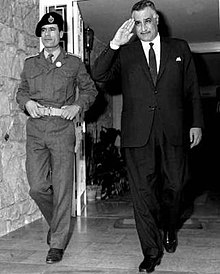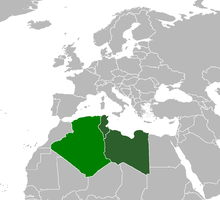Arab Islamic Republic
|
Libyan-Tunisian Union Arab Islamic Republic |
|
 Flag of the Arab Islamic Republic |
|
 Map of the Arab Islamic Republic |
|
| Official language | Arabic |
| Capital | not fixed |
| founding | officially never completed |
The Arab Islamic Republic ( Arabic الجمهورية العربية الإسلامية al-Dschumhuriyya al-'arabiyya al-Islamiyya , DMG al-Ǧumhūrīya al-'arabīya al-Islamiya ), also Libyan Tunisian Union was a planned unification of the two countries Libya and Tunisia , which by the Libyan leader Muammar Gaddafi and the Tunisian President Habib Bourguiba was proposed.
Regional overview
The planned unification of Libya with Tunisia was related to the Arab striving for unity and was a forerunner of the Union of the Arab Maghreb . Due to the many similarities of the Maghreb states, there have always been movements that sought unification or cooperation in Algeria , Libya , Morocco , Mauritania and Tunisia . The ideal of a Maghreb union is mentioned in the constitutions of Algeria, Morocco and Tunisia. However, this initially failed due to the competing interests of the two regional great powers Algeria and Morocco. A Tunisian proverb says: “If there were only Algeria or Morocco, a Maghreb Union would not be possible. The only great power would swallow us. In order to reach the Maghreb Union, both rival great powers are necessary. ”A regional organization would therefore bind the rival forces and require cooperation between the states.

In addition, even the play pan-Arabism and the other Arab states with their common heritage an important role in the region. Muammar al-Gaddafi, a proponent of Arab unity, sought a union of Libya with Egypt , Sudan , Syria , Chad and Tunisia. That is why Libya had already founded the Federation of Arab Republics with Egypt and Syria . In Tunis on December 17, 1972, he proposed Tunisia's accession to the federation or a union of Libya with Tunisia. During Gaddafi's speech, which was broadcast live on the radio, Tunisian President Bourguiba rushed to Gaddafi's address and then gave a speech in which he criticized Gaddafi's idea. He said that the Arabs were once united (unsuccessfully) and rejected Gaddafi's idea. In June 1973, however, Libya and Tunisia signed an economic and labor agreement.
At the fourth conference of the Movement of Non-Aligned States from September 5 to 9, 1973 in Algiers , the Tunisian President Bourguiba called for the unification of Algeria, Libya and Tunisia for an "indefinite period" ("United States of North Africa").
The Djerba Declaration
On January 11, 1974, Bourguiba and Gaddafi signed the Djerba Declaration , in which the unification of Libya and Tunisia into the Arab Islamic Republic was resolved. Referendums have been planned in both countries. This quick action by Gaddafi differed from his action against Egypt, with which an alliance previously failed. It is possible that Bourguiba was also interested in a merger with Libya in order to free it from the influence of Egypt.
This quick agreement surprised observers and experts, who were of the opinion that Bourguiba did not support a merger, since Gaddafi's speech in Tunis had led to tensions between Libya and Tunisia. Bourguiba's rethinking could also have been due to the fact that 30,000 Tunisians worked in Libya and thus supported the Tunisian economy. In addition, Tunisia suffered from unemployment, high debt and a shortage of raw materials, and a merger with the richer Libya was therefore a welcome solution. However, the reasons that ultimately led Bourguiba to agree to the union with Libya have not been clearly established. By contrast, it is known that many Algerians and Tunisians viewed the Djerba Declaration critically.
The Djerba Declaration provided for a government, an army and a president for the Arab Islamic Republic. Bourguiba would become the president and Gaddafi the defense minister. On the other hand, no solutions or compromises were found for other criteria such as trade, customs duties, investments, regulations for immigrants, social security and the creation of a single shipping company. However, agreement on these points was not considered as important as the union of the two states. Bourguiba received support for the establishment of the union from some Tunisian members of the government, for example from the well-known Foreign Minister Muhammad Masmudi .
How long the republic existed is a matter of dispute. The times range from one day to one month. By contrast, it is known that Tunisia benefited from the merger with Libya, but did not give up its sovereignty. The Socialist Party of Tunisia criticized the Union for failing to create clear regulations between the two states and for not regulating the precise powers of the ministries. As a result, Bourguiba changed his mind about the Union. The referendum in Tunisia was postponed on January 12, 1974, Tunisia withdrew from the Djerba Declaration and the Foreign Minister Masmoudi was dismissed. Before that, Gaddafi still hoped that the Union would promote Arab unity. After the successful establishment of the European Community and Bourguiba's quick retreat, Bourguiba's government and ability to govern was called into question.
Failure of the Djerba Declaration
It is unclear why the Djerba declaration failed before the referendums took place. It is possible that too great differences in the interests of both states are responsible for a failure. Tunisia, modeled on the former mother country France , was governed liberally and had a secular character. Education was the top priority, as was women's rights , social policies and an advanced infrastructure . For these reasons, the government oriented itself towards the founder of Turkey , Mustafa Kemal Ataturk . Gaddafi, on the other hand, was interested in an Islamic socialist state. He rejected secularization and westernization and was politically anti-western.
As a consequence, there was an irreconcilable difference which made it difficult for the two states to reach agreement. Bourguiba was of the opinion that the two states would not go together, but that cooperation would be possible. In contrast, Gaddafi was more interested in full integration of both states in the republic. He saw Libya more as a revolutionary movement than as a state. In Gaddafi's opinion, Libyans and Tunisians were one people and the borders were only drawn by “conquerors and imperialists”.
Ultimately, regional political differences made union difficult. Egypt-Libyan relations deteriorated after 1973. Due to the diminishing influence of Egypt in the region, Algeria increasingly rejected the unification of Libya and Tunisia. In the first 24 hours after the founding of the Arab Islamic Republic, Algeria threatened Tunisia with military measures if Tunisia were to unite with Libya. In addition, the Tunisian Foreign Minister Muhammad Masmudi was accused of bribery by Libya.
See also
Individual evidence
- ↑ Ghaddafi signed a "second choice marriage" ( Memento from July 28, 2014 in the Internet Archive )
- ↑ Aghrout, A. & Sutton, K. (1990). Regional Economic Union in the Maghrib. The Journal of Modern African Studies , 28 (1), 115
- ^ Deeb, MJ (1989). Inter-Maghribi Relations Since 1969: A Study of the Modalities of Unions and Mergers. Middle East Journal, 43 (1), 22
- ^ Deeb, MJ (1989). Inter-Maghribi Relations Since 1969: A Study of the Modalities, Unions and Mergers. Middle East Journal , 43 (1), 23
- ↑ a b c d Wright, J. 1981. Libya: A Modern History . London: Croom Helm, 165
- ^ Deeb, MJ (1989). Inter-Maghribi Relations Since 1969: A Study of the Modalities of Unions and Mergers. Middle East Journal , 43 (1), 24
- ↑ a b c d e Simons, G. 1993. Libya: The struggle for Survival . New York: St. Martin's Press, 253
- ^ Deeb, MJ "Socialist People's Libyan Arab Jamahiriya" in The Government and Politics of the Middle East and North Africa. 4th ed . David E. Long and Bernard Reich eds. Boulder, CO: Westview Press, 386. Online ( Memento of the original from May 19, 2011 in the Internet Archive ) Info: The archive link has been inserted automatically and has not yet been checked. Please check the original and archive link according to the instructions and then remove this notice. (April 4, 2008).
- ↑ Broken Engagement, January 28th, 1974, Time Magazine , Online
- ↑ El-Kikhia, MO 1997. Libya's Qaddafi: The Politics of Contradiction . Gainesville, FL: University Press of Florida, 121
- ↑ a b c d Simons, G. 1993. Libya: The struggle for Survival . New York: St. Martin's Press, 254
- ↑ El-Kikhia, MO 1997. Libya's Qaddafi: The Politics of Contradiction . Gainesville, FL: University Press of Florida, Jan.
- ^ A b Wright, J. 1981. Libya: A Modern History . London: Croom Helm, 166.
- ^ Borowiec, A. 1998. Modern Tunisia: A Democratic Apprenticeship . Westport, CT: Praeger Publishers, Jan.
- ↑ a b Zartman, IW (1987). Foreign Relations of North Africa. International Affairs in Africa (Jan), 18.
- ^ Deeb, MJ (1989). Inter-Maghribi Relations Since 1969: A Study of the Modalities of Unions and Mergers. Middle East Journal, 43 (1), 26.
- ^ Deeb, MJ (1989). Inter-Maghribi Relations Since 1969: A Study of the Modalities of Unions and Mergers. Middle East Journal, 43 (1), 25.


